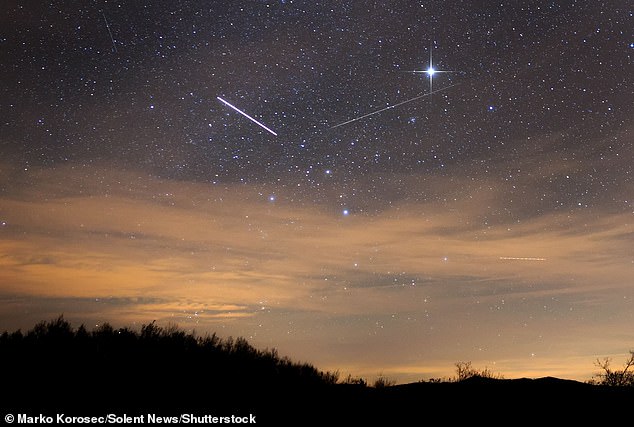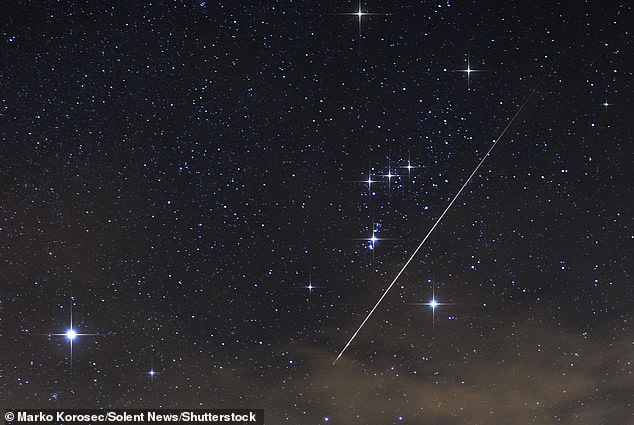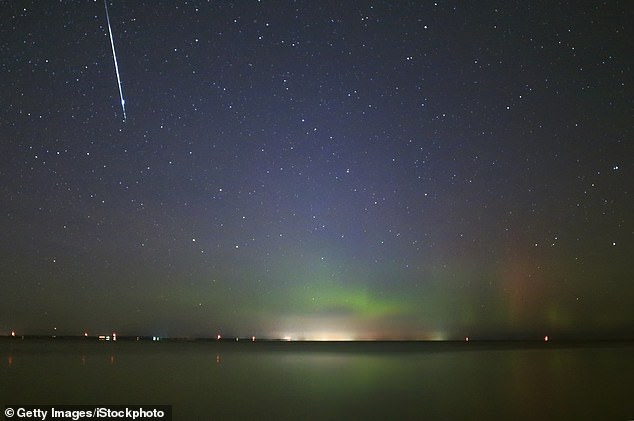Taurid Meteor Shower will peak this week with up to 5 shooting stars every hour – here’s how to see them from the UK
>
It’s almost time to get out of your camping chair and sip your tea, as the night sky will be filled with a stunning shower of meteors ‘fireballs’ this weekend.
From 12 to 13 November, the Taurid Meteor Shower will reach its peak with up to five meteors visible every hour from the UK.
As Earth passes through the debris cloud left by Comet Encke, meteorites up to three feet (1 meter) long can be seen burning up in Earth’s atmosphere.
These slow-moving meteors will be visible until December 10 in the Northern Hemisphere, but will be more numerous this weekend.
Best of all, experts say no special equipment will be needed to view this impressive display, as meteors are best seen with the naked eye.
This weekend, the Taurid meteor shower will reach its peak. From the Pleiades constellation, viewers should be able to see the bright meteor moving relatively slowly

Meteor showers get their name from the region of the sky from which they appear to emerge. In this case he is a Taurus
Dr. Greg Brown, an astronomer at the Royal Greenwich Observatory, explains that the meteor shower occurs at the same time every year due to predictable patterns of space debris.
“When Earth passes through the cloud of debris left behind by a comet or asteroid in our solar system, pieces of rock and dust will be swept away, crashing into our atmosphere and producing a bright streak of light in our sky: a meteorite,” he told MailOnline.
“These meteor showers occur at fairly predictable times in our year, and they appear to originate from a specific part of our sky based on the direction the Earth is heading at that time.”
The Taurid shower and Comet Encke are believed to have once been part of a much larger comet that slowly split into pieces over the past 20,000 to 30,000 years.
When comets travel through the solar system, they pass so close to the sun that they instantly turn part of its surface from solid ice into clouds of gas.
These clouds stay at the same point in Earth’s orbit, which means meteor showers always appear to come from the same place in the night sky.
In the case of the Taurus meteor shower, meteors appear to emerge from the constellation Taurus, which gives it its name.

This will be a slow year for the Taurus meteor shower, but the meteors should be bright enough to be seen clearly with the naked eye.
The meteors seen during Taurus showers are slow-moving and particularly bright, making them easy to see with the naked eye.
Most are classified as “fireballs,” meaning they appear brighter than Venus — the brightest thing in the night sky after the Moon.
Although they may appear to be moving slowly to us, the meteors are actually moving at 17 miles per second (27 km/s), or 65,000 mph (104,607 km/h).
Unfortunately, Dr. Brown says this year will not be a particularly good year for the Taurid meteor shower compared to other showers in the past.
He told MailOnline: ‘This shower is not particularly strong, with only around 5 meteors per hour at its peak, which can be significantly reduced by your observing conditions.’
To get the best view of meteors, you should find a place that has as little artificial light as possible because this will make it easier to spot meteors.
The Moon will be very bright at the peak of the shower, at 44%, but Taurus should be bright enough that this won’t make much of a difference.
Avoid directing any lights into your eyes, including looking at your phone, and give your eyes enough time to adjust to the darkness.
“To see them, head to a place with a low horizon, with no trees or buildings in the way, ideally after midnight to increase your chances,” Dr Brown said.
“Fill your view with the sky and wait.” There is no point in trying to use a telescope or binoculars because their vision is so small.
With the weather expected to be very cold during peak showers, remember to pack warm clothes because you may be waiting a long time to see the meteors.
The Met Office is forecasting cloud cover and some possible rain across much of the UK on Sunday, with temperatures falling below 50 degrees Fahrenheit (10 degrees Celsius).

The Taurus meteor shower will be active until December 10, but there will be significantly fewer meteors to see. However, there will be three more meteor showers this year to see.
If you missed your chance to see the Taurid meteor shower, don’t worry, as there are three more meteor showers you can spot before the end of the year.
Between November 17 and 18, the Leonids will reach their peak activity, followed by the Geminid between December 13 and 14.
Finally, concluding the stargazing year, the Ursids meteor shower will peak between December 21 and 22.
Throughout the entire year, those with their eyes on the sky may also be able to spot sporadic meteors.
These random pieces of space debris consist mostly of material from asteroids, which are large pieces of rock, not from icy comets.
They can appear from any direction in the night sky, and generally pass through the atmosphere at a rate of one every ten minutes.
(Tags for translation)dailymail
